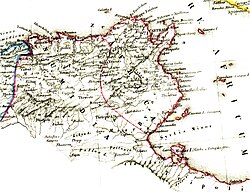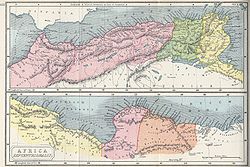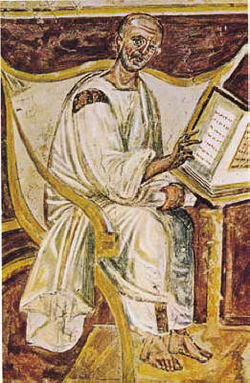| English | Berber | Latin | Sardinian | Italian | Corsican | Sicilian | Maltese [136] |
| sin / sickness / little child (lit., "without sin") | abekkaḍu / abăkkaḍ / war-abekkadu / war-ibekkaden | peccatum ("sin"; "error"; "fault") | pecadu / pecau ("sin") | peccato ("sin") | pecatu ("sin") | piccatu ("sin") | |
| wether (castrated ram) [140] | aberkus | vervex / berbex > *berbecus(?) | berbeghe / berveghe / barveghe / barbeghe / verveche / berbeche / erveghe / ilveghe/ barbei / brabei / brebei / erbei / arbei / brobei / ebrei | berbice | | | |
| celery | abiw | apium ("celery"; "parsley") | àpiu / àppiu | appio | | accia | |
| road / path | abrid / tabrida | veredus ("fast or light breed of horse") | | | | | |
| oven | afarnu / affran / afferan / ufernu / ferran / afurnu / tafurnut | furnus | furru / forru | forno | fornu / forru / furru | furnu | forn |
| chicken / chick | afullus / afellus / fiǧǧus / fullis | pullus | puddu | pollo | pullastru | puḍḍu / pollu | fellus |
| fresh curd / to curdle / curdled milk | aguglu / kkal / ikkil | coagulari / coagulum ("to curdle"; "curd"; "bind/bonding agent"; "rennet"; "rennet") | callu / cazu / cracu / cragu / giagu ("rennet") | caglio ("rennet") | caghju ("rennet") | quagghiu / quagliu ("rennet") | |
| agaric | agursal / arsel | agaric > *agaricellum | agarico | agarico | | | |
| boat | aɣeṛṛabu | carabus | | | | | |
| oak | akarruš / akerruš | cerrus / quercus | chercu | quercia | quercia | querchia | |
| elevated part of the bedroom | alektu / řeštu | lectus ("bed") | letu ("bed") | letto ("bed") | lettu ("bed") | lettu ("bed") | |
| oleander | alili / ilili / talilit | lilium (lily) | lizu / lilliu / lillu / lixu / lìgiu / gixu / gìgliu / gìsgiu ("lily") | giglio ("lily") | gigliu ("lily") | gigghiu ("lily") | ġilju ("lily") |
| alms / religious compensation | amerkidu / amarkidu / emarked / bu-imercidan | merces ("pay"; "wages"; "reward"; "punishment"; "rent"; "bribe") | merchede ("pay"; "recompense") | mercede ("recompense"; "merit"; "pity"; "mercy") | | mercedi / mircedi ("remuneration"; "payment"; "wage"; "salary"), merci (merchandise"; "goods") | |
| olive marc | amuṛeǧ | amurca | | morchia | | mùrija / muria | |
| angel / spiritual entity / child / type of illness | anǧelus / anǧalus / anglus / ănǧălos / ăngălos / anaǧlusan / wanaǧlusan / anglusen [157] | angelus | àgnelu / ànzelu / ànghelu / àngelu | angelo | anghjulu | àncilu / ànciulu | anġlu |
| to light up / illuminate / light / lamp [158] | amnar | limino, liminare / lumino, luminare | | luminare | | | |
| (large) sack / double bag/donkey's saddle / tapestry | asaku / saku / sakku / saču | saccus | sacu | sacco | saccu | saccu | saqqu |
| donkey / ass | asnus | asinus | àinu | asino | asinu | àsinu | |
| belonging to or attached to a yoke | ašbiyo / ašbuyo | subiugius | sisùja / susùja | soggiogo | | | |
| helm | aṭmun / aṭmuni | temo ("pole"; "tongue of carriage"; "beam") | timona / timone / timoni | timone | timone | timuni | tmun |
| August | awussu | augustus | agustu / austu | agosto | aostu / agostu | Austu | Awwissu / Awissu |
| blite | blitu | blitum | | bieta ("beet": from beta, "beet" + blitum, "blite") | | jiti / ajiti / agghiti / gidi / nciti / aiti ("beet": from beta, "beet" + blitum, "blite") | |
| young boy | bušil | pusillus ("small") | pusiddu ("small boy") | pusillo ("small") | | | |
| thrush (bird, in family turdidae | ḍerḍus / ḍorḍus | turdus | | tordo | tôdula | turdu | |
| large wooden bowl | dusku | discus | discu | disco | discu | | |
| (drawing) rule / vertical beam of weaving loom | errigla | regula ("rule / bar / ruler") | regra / arregra / rega / rega / regia / reja | reglio (rare) / regola (later borrowing) | rica / riga | règula/ rèjula (later borrowing) | regola (later borrowing) |
| bearded vulture / bird of prey | falku / afalku / afelkun / fařšu | falco ("falcon") | | falco / falcone ("falcon") | falcu ("falcon") | farcu / farcuni / falcuni ("falcon") | falkun ("falcon") |
| locality in Tripolitania | Fassaṭo | fossatum(?) ("ditch", e.g. as fortification) | | fossato ("ditch") | | fussatu ("ditch") | foss ("ditch") |
| pennyroyal | fleyyu / fliyu / fleggu | pulegium / puleium / puledium / pulleium / pulledium | | poleggio / puleggio | | | |
| February | furar | februārius | freàrgiu / frearzu / fiàrzu | febbraio | ferraghju / farraghju / frivaghju | Frivaru | Frar |
| hen-house | gennayru | gallinarium | | gallinaio | | gaḍḍinaru / jaḍḍinaru | |
| castle / village | ɣasru | castrum (diminutive: castellum) | casteddu | castello | castellu | casteḍḍu | qasar / kastell |
| bean | ibaw / awaw [178] | faba | faa / faba / fae / fava | fava | | fava / fafa | |
| evil spirit | idaymunen [157] | daemon / daemonium ("lar, household god"; "demon, evil spirit") | | demone / demonio | dimoniu | dimoniu | |
| fern | ifilku | filix | filiche / filighe / filixi / fibixi / fixibi | felce | filetta | fìlici | felċi |
| thread | ifilu | filum(?) ("thread; string; filament; fiber") [179] | filu | filo | filu | filu | |
| vulture [180] | i-gider | vultur | | avvoltoio / avvoltore / voltore / vultore / vulture | | vuturu / avuturu | avultun |
| pear / pear tree | ifires / tfirast / tafirast | pirus (feminine: pira, "pear fruit") | pira ("pear fruit") | pero | pera ("pear fruit") | piru | |
| cultivated field | iger / ižer | ager | agru | agro | acru | agru | |
| laborer (to plough) | ikerrez | carrus ("wagon; cart; wagonload", from Gaulish) | carru | carro | | carru | |
| chickpea | ikiker | cicer | chìghere / cìxiri | cece | cecciu | ciciri | ċiċri |
| horehound | immerwi | marrubium | marrubiu | marrubio | | marrubbiju | marrubja |
| sea squill / sea onion (Drimia maritima) | iskil | squilla / scilla | aspidda | squilla | | | |
| rye | išenti / tāšentit | centenum ("rye; something gathered hundred each") | | | | | |
| durmast | iskir | aesculus | | eschio / ischio | | | |
| fig (in the stage of pollination) / artichoke | karḍus (first definition) / ɣerdus / ɣerda (second definition) | carduus ("thistle"; "artichoke") | | cardo ("thistle") | cardu ("thistle") | cardu ("thistle") | |
| bug / bedbug | kumsis | cimex | chímighe | cimice | cimicia | cìmicia | |
| wall | muṛu / maṛu | murus | muru | muro | muru | muru | |
| cat | qaṭṭus / takaṭṭust / yaṭṭus / ayaḍus / qeṭṭus | cattus | gatu / atu / batu / catu | gatto | ghjattu / gattu / ghiattu | jattu | qattus |
| Rif (locality in Morocco) | Rif | ripa(?) ("shore"; "bank") | | ripa ("shore"; "bank") | | | |
| feast / religious celebration / springtime | tafaska / tafaske / tabaski / tfeskih | pascha ("Easter"; "Passover") | Pasca ("Easter") | Pasqua ("Easter") | Pasqua ("Easter") | Pasqua ("Easter") | |
| cauldron / iron bowl / cooking jug | tafḍna / tafeḍna / tafaḍna | patina ("shallow pan or dish for cooking"; type of cake; "crib") | | patina ("patina"; "coat"; "film"; "glaze"; "size") | | | |
| carrot | tafesnaxt | pastinaca ("parsnip"; "stingray") | pastinaca / pistinaga / frustinaca ("parsnip"; "carrot") | pastinaca ("parsnip") | pastinaccia / pastricciola ("parsnip") | bastunaca / vastunaca ("parsnip") | |
| bud or eye of a plant / gem / jewel [158] | tagemmut | gemma | | gemma | | | |
| crow | tagerfa | corvus [188] | colbu / crobu / colvu / corbu / corvu | corvo | corbu | corvu / corbu | |
| throat | tageržumt | gurga(?)(Late Latin, from gurges, "whirlpool") | | gorgia (archaic) | | gargiularu | gerżuma |
| thing | taɣawsa / tɣawsa / taghaussa / tghussa [191] | causa ("case"; "reason/cause"; "motive"; "condition/state"; "justification") | cosa (inherited from Italian; Old Sardinian, casa) | cosa | còsa | cùosa | |
| various toponyms | Taɣlis / Taɣlisiya / iglazen / iglis / Tarlist | ecclesia(?) ("church") | chegia / cheja / creia / crèsia ("church") | chiesa ("church") | chiesa / ghiesgia / jesgia ("church") | chìesa / chisa / chesa / clesia / crèsia / crièsia ("church") | |
| wax | takir | cera | chera / cera | cera | cera | cira | |
| quince | taktuniyt / taktunya | (malum) cydonium / cotonium / cotoneum (plural cydonium / cotonia) | chidonza / chintonza / chitonza | cotogno ("quince tree") / cotogna ("quince fruit") | melacutona / melacutugnu | cutugnu / cutugna | |
| seaweed | talga | alga | alga | alga | | àlica | alka |
| file | talima / tilima / tlima [194] | lima | lima | lima | | lima | |
| irrigation channel | targa | *riga(?) < irrigo("to water/irrigate/flood") [195] | | irrigare ("to irrigate") | | irrigà ("irrigate") | | |
| weapon | tarma | arma | àrma | arma | arma | arma | arma |
| madder (red-dye) | tarubi / tarubya / tarrubya / awrubya / tṛubya | rubia | | robbia | | | |
| ladder | taskala | scala ("ladder"; "stairs") | iscala / issala / scaba | scala | scala | scala | |
| pod (of pea or bean) / carob | tasligwa / tasliɣwa / tisliɣwa / tasliwɣa | siliqua | silimba / silibba / tilimba / tilidda | serqua | | | |
| pair / pair of drought animals, oxen | tawgtt / tayuga / tayugʷa / tayuggʷa / tyuya / tiyuyya / tiyuga / tǧuǧa / tguget / tiugga | iugum ("pair of drought animals"; "yoke"; "couple") | jugu / giugu / giuu ("yoke") | giogo ("yoke") | jugu ("yoke") | giugu ("yoke") | |
| pine | tayda | taeda ("pinewood") | | teda | | deda | |
| shirt | tekamest | camisia | camigia / camisa | camicia | camisgia / camigia / camicia | cammisa | qmis |
| elbow | tiɣammar / taɣomert / tiɣumert | camur < camur ("bent"; "curved"; "hooked") | cambra ("clamp"; "cramp") | | | | |
| lentil | tilintit / tiniltit | lens | lènte / lentìza | lente / lenticchia | lintichja | lenti / linticchia | |
| shoemaker's awl | tissubla / tisubla / tsubla / tasubla / tasobla / tasugla / subla | subula | | subbia ("chisel") | | | |
| catapult | tfurka / afurk / tfurket | furca ("fork"; "pitchfork"; "pole"; "stake") | frúca / furca ("fork"; "pitchfork") | forca ("fork"; "pitchfork") | | furca ("fork"; "pitchfork") | |
| mulberry tree | tkilsit / tkilsa | (morus) celsa | chersa / chessa | gelso / moro | | ceusu | |
| piece of paper | tkirḍa / tkurḍa / takerḍa / takarḍe, tyerṭa | carta / charta ("paper"; "papyrus") | carta / calta | carta | carta | carta | karta |
| wooden board for making doors / irrigable field (second two forms listed) | toḍabla / taġult / tiġula | tabula ("board"; "tablet") | taula ("piece of wood") | tavola ("table"; "slate") | tavula ("table") | tàvula ("table") | |
| theater [140] | ṭyaṭir | theatrum | teatru | teatro | teatru | tiatru | teatru |
| wooden board for making doors / irrigable field (second two forms listed) | toḍabla / taġult / tiġula ("elm") | ulmu | ulmus | úlimu / úlumu / urmu | olmo | olmu | urmu | |
| stove / cooker | θafkunt | *focone(?) < focus ("fire"; "fireplace"; "hearth"; "coalpan") | fogu / focu ("fire") | fuoco ("fire") | focu ("fire") | focu ("fire") | |
| rope | θasuχa | soca | soga | soga | | | |
| field / garden | urṭu / urti | hortus ("garden") | oltu / ortu / otu ("vegetable garden") | orto ("vegetable garden") | ortu ("garden") | ortu ("vegetable garden") | |
| white mustard (Sinapis arvensis) | (w)ašnaf / hacenafiṭ / hacenafṭ / wayfes / waifs | senapi(s) / sinapi(s) / senape / sinape(?) | | senape | | sinapi | |









